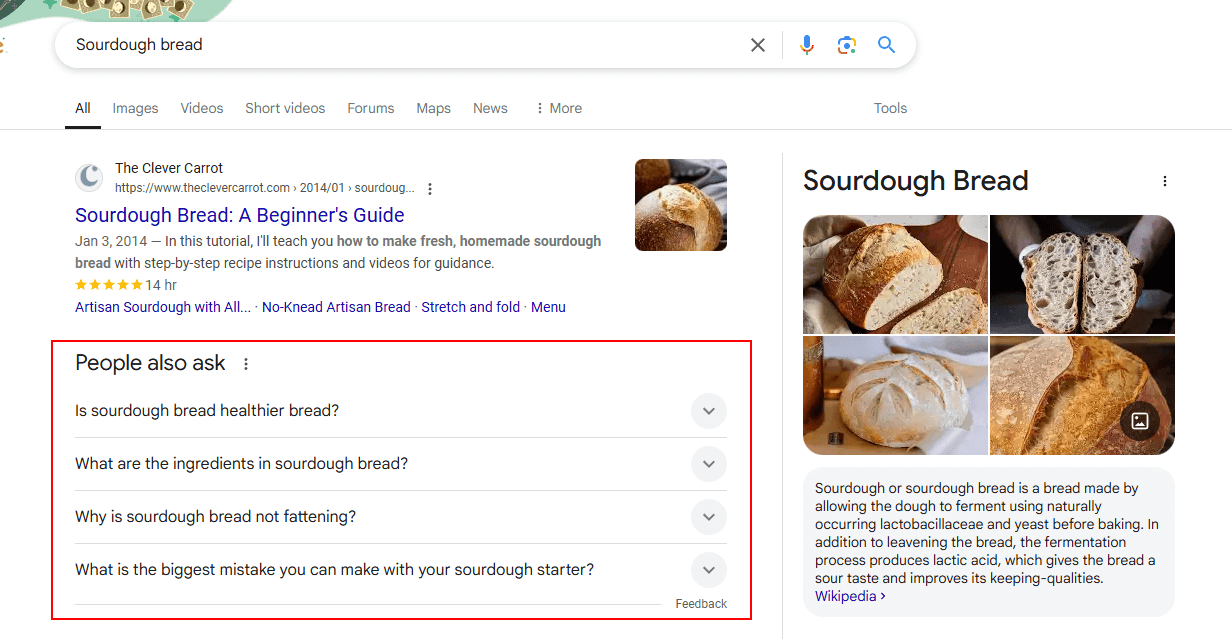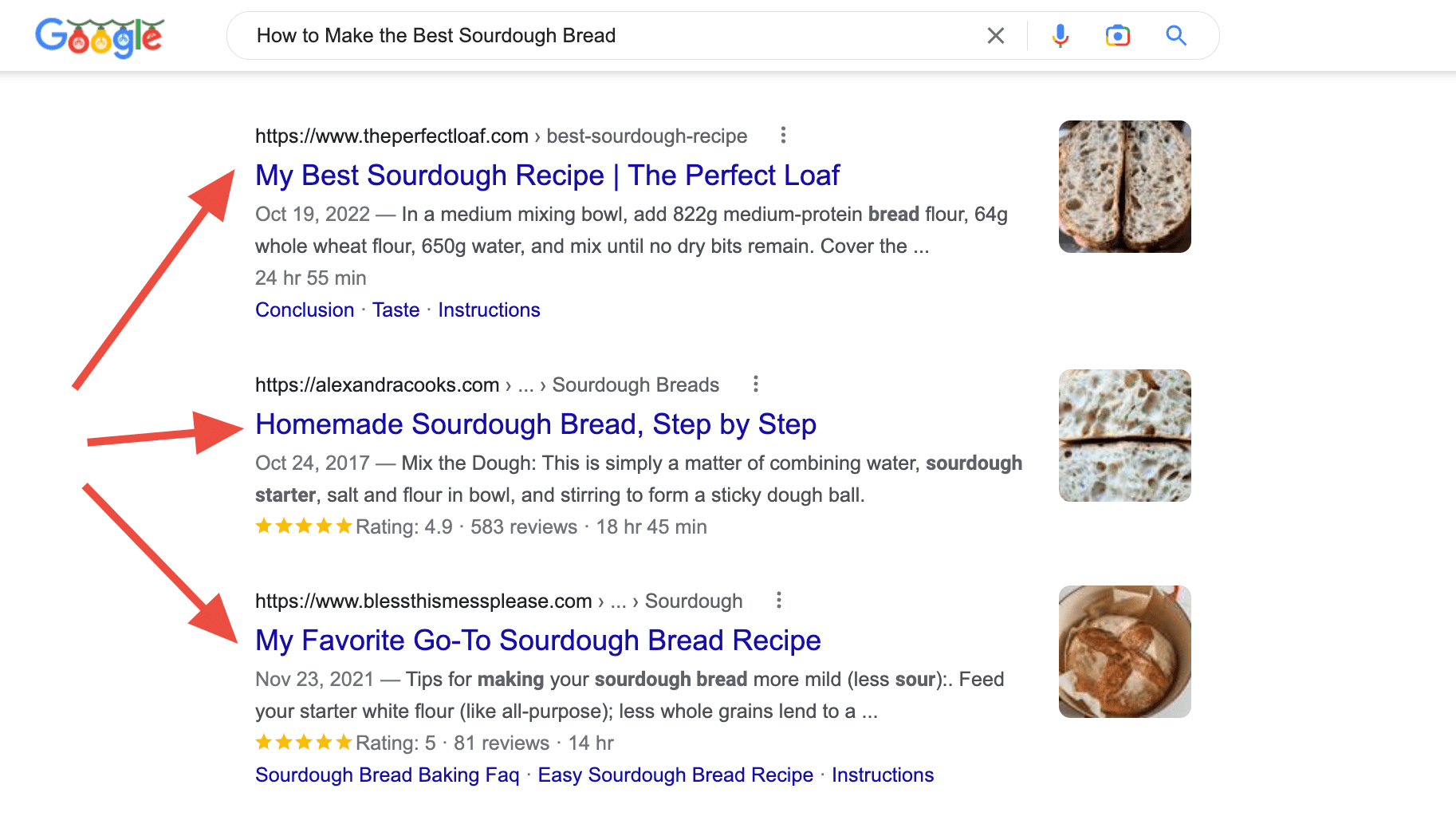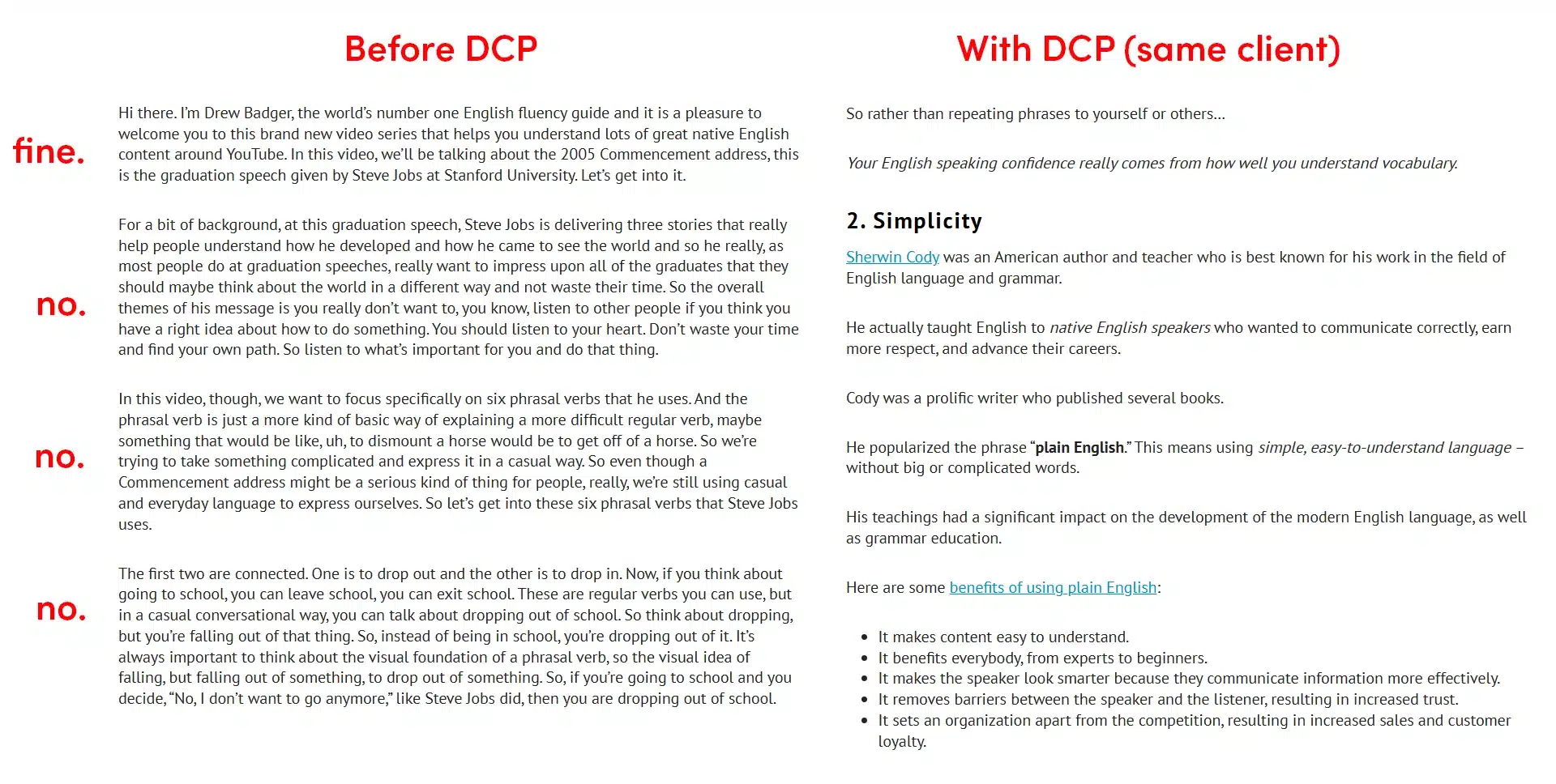There are two types of articles most businesses invest in.
- “SEO articles” to drive traffic
- Well-crafted articles to drive sales
We’re here to talk about driving sales and how to write articles to do just that. But for 30 seconds, let’s switch gears.
No one ever admits to reading the end of a book first, but we’ve all done it. And the last time you Googled a recipe you needed, I’m sure you jumped straight to the end first, right? It’s alright. We all do it.
When I’m looking up “What’s the best sourdough recipe?” I don’t care about your backstory. I need a recipe.
You can argue that “it’s driving traffic.” You need 2000 words of preamble – that readers will sail past looking for the recipe at the end – to win that traffic.
That’s fine if you’re business runs on traffic alone, but ours runs on sales. For the moment, let’s assume yours does too.
The difference between writing an SEO article and one focused on driving sales is subtle yet crucial to your success. The mechanics will feel familiar, but how you approach it needs to change.
It’s been 30 seconds, so let’s get into it.
Originally published on December 12th, 2022, this article was updated and republished on March 19th, 2025.
Our SEO Services May Be Perfect for You
We’ve been turning keywords into ROI since 2006. Take the next step and learn how our approach to keyword research will transform your business.
Step 1. Know Your Audience (Really Well)
If you write it, they will read it.
While it’s a nice thought, that’s not how it works.
Your ideal customer is looking for specific information related to your product or service. But how do you get the knowledge you have in front of the right people?
Answer: You need to understand your target audience beyond surface-level demographics.
Think beyond the broad categories of age, job title, or industry. Instead, imagine a single customer—someone who has asked your business a question before, a client you wish you had, or a prospect who’s close to purchasing but needs just a little more information.
For example, let’s say you run a bakery that specializes in artisan sourdough bread. If your blog post is written for “people who like bread,” it’s too generic.
Rather, write with a specific person in mind. Imagine Emily, a home baker who has tried making sourdough multiple times but struggles to get the perfect crust and airy crumb.

If Emily lands on an article titled, How to Bake Artisan Sourdough with the Perfect Crust – A Step-by-Step Guide for Home Bakers, she’s far more likely to keep reading.
Make Sure Your Content Aligns with Your Audience
This is where many businesses go wrong. If your ideal reader is someone like Emily, an article about The History of Sourdough won’t help her. Neither will a deep dive into fermentation science filled with jargon—she just wants clear, actionable steps about how to bake a respectable loaf.
Misalignment happens when content is written for the wrong audience or doesn’t address their real pain points. Instead of guessing what your readers need, use tools like Google Search Console (GSC) and keyword research tools to see what people are actually searching for.
Pay attention to customer questions, FAQs, and social media discussions to ensure your content stays relevant and useful.
Step 2. Answer What Your Audience Is Asking
Again, this seems obvious, but many businesses skip this step. This can result in attracting the wrong traffic, which doesn’t drive sales. On the other hand, it can lead to not getting any traffic because they didn’t do any keyword research.
To write a successful blog post, you need to know what questions your target audience is asking.
What phrases are they typing into search engines? What words come up again and again?

It helps to understand search engine optimization (SEO) and keyword research. But your reader isn’t an algorithm, and you won’t win them over by writing that way.
The goal is to find topics your audience cares about and ensure they can find your blog post when they’re looking for answers. So you need to know which phrases or questions readers are typing into search engines and use that information to guide your topic selection.
For example, if someone is looking for recipes for sourdough bread, the questions, phrasing, and volume of terms can vary.

Why does this matter? Because you don’t want to answer general queries. You want to tackle the specific questions your target audience needs answered.
To find the right questions (possible blog topics), you can try the following:
- Google: Type in a general search term and see what appears under “people also ask” and “Related searches.”
- AnswerThePublic: To get consumer insight, just go to AnswerThePublic and type in a search phrase, topic, or brand to get a comprehensive analysis of what people are searching for.
- X: Use X search to find words, phrases, or hashtags to find out what people are talking about.
No matter what method(s) you choose, having these keywords and search phrases on hand makes your content helpful and relatable.
This research should guide your topic ideas. Your blog becomes a valuable resource as you build up an archive of helpful content, explicitly addressing your reader’s questions and concerns.
That personal touch can make all the difference between a person continuing with the next steps or checking out and moving on to another post. It’s the difference between meaningless traffic and potential sales.
Step 3. Choose the Right Type of Article for Maximum Impact
Before you start writing, get clear on your goal. Are you trying to convert readers into customers, educate them, build a connection, or establish authority? The type of article you choose will shape everything—from structure to tone to messaging.
If your goal is conversion, a persuasive article works best.
These position your product or service as the solution to a specific problem and push the reader toward action, whether that’s making a purchase, signing up for a newsletter, or booking a consultation. Think case studies, product comparisons, or urgency-driven content.
For example: “Why Your Coffee Grinder Is Holding You Back (And How to Fix It for the Perfect Brew).”
If you want to educate your audience, focus on informative content.
These articles provide value without a sales pitch—helping readers understand a topic, solve a problem, or make better decisions. How-to guides, FAQs, and deep dives work well here.
For example: “How to Choose the Best Hiking Boots for Any Terrain.”
For a more personal touch, storytelling-based articles create a connection.
Whether it’s a personal anecdote, a customer success story, or a behind-the-scenes look at your brand, these articles make your content more relatable and memorable.
For example: “From a Garage to a Gourmet Bakery: How One Baker’s Passion Became a Household Name.”
Finally, if you want to establish yourself as an authority, thought leadership content is the way to go.
These pieces offer original insights, industry predictions, or bold perspectives that attract high-quality leads and PR opportunities.
For example: “The Future of E-Commerce: How Small Businesses Can Compete with Giants in 2030.”
Step 4. Lure Readers in with an Engaging Headline
Your headline is your first (and sometimes last) impression on readers. So make it count!
The goal is to let readers know the topic and entice them with something of value.
It’s worth the extra time to make your headline stand out. Just think of all the Google searches you’ve done. You likely skipped thousands of posts because they didn’t catch your attention. They didn’t address your problem. They didn’t offer a solution.
They didn’t lure you in.
If you’re writing a post about how to make the best sourdough bread, a title like “How to Make the Best Sourdough Bread” is pretty clear about the topic. But will it catch the reader’s attention?

Probably not.
The above examples are okay – but what if we tweaked them a bit?
- The Perfect Sourdough Loaf: The One Recipe to Rule Them All
- A Step-by-Step Guide to Guide to Making Perfect Sourdough Bread
- My Favorite Go-To Sourdough Bread Recipe: And Soon to Be Yours!
All it takes is a bit of time and some imagination. So, get creative with your titles to stop scrollers in their digital tracks.
Beyond engagement, keyword placement in headlines is crucial for SEO. A well-optimized title helps search engines understand your content and improves click-through rates (CTR).
For example:
- How to Make Bread—pretty generic.
- How to Make the Perfect Sourdough Bread at Home – Step-by-Step Guide—way better.
Using relevant keywords naturally makes your title both SEO-friendly and compelling for readers.
People are far more likely to read a post with a headline that goes a step or three further than the rest. Remember, competition is fierce – you have to stand out, and the title is the first place to do that.
If you need some help, check out these headline formulas that work.
Subheadings Need Attention, Too
While drafting your blog post, it’s essential to remember that your subheadings are just as important as your headline.
Subheadings should ask a compelling question or clearly state a benefit.
Here’s a before-and-after example:
- Before: Common Problems in Article Writing
- After: Struggling to Write an Article? Here’s How to Fix Common Mistakes
See the difference? The second version is engaging and signals value to the reader.
The world’s best heading won’t save your post from being skipped if your subheadings are dull or useless.
Step 5. Nail Your Intro
You’re here because you want people to actually read your posts, not just click on the headline, right?
(If not, you’re probably wondering why there isn’t a sourdough recipe yet.)
Here’s a hard truth: A weak intro loses readers before they even start.
The goal of your intro is to hook the reader and keep their attention.
What’s your angle? Why should your reader care about what you wrote? You get one shot to stop a prospect from leaving your page to find one that’s more interesting, relevant, or useful.
So if you want people to read your blog post (all of it), you need to open strong. Try one of these openings:
- Ask a question (make the reader think)
- Use an analogy or metaphor (relate to the reader)
- Create a mental picture (engage the reader’s imagination)
- Cite a persuasive statistic (interesting facts or stats the reader can’t ignore)
- Share a funny story (cause the reader to feel something)
If you do one of the above, you’re on your way to nailing your intro.
What do I mean by on your way?
Simple, there’s another half to the formula for nailing your intro. You also need to let the reader know they’re getting something of value.
I know what you’re thinking – that’s too much pressure for a few paragraphs of introduction to handle – but it can be done. I promise.
If someone lands on your blog, chances are a search got them there. They typed in a question or phrase you researched and strategically used in your post for that very moment.
Now is your time to shine.
Make it clear in your intro that your post will provide answers. You’ll have the rest of the article to give fresh insights and unique takes on the topic. However the intro has to make clear that readers are in the right place to find the answers they need.
Let’s say you’re optimizing a product description for SEO.
A weak intro might look something like:
Writing product descriptions is an important part of ecommerce. Good descriptions help customers understand the product and improve sales.
You could strengthen it by saying:
Your product description is the difference between a browser and a buyer. If you’re not optimizing it for search engines and conversions, you’re leaving money on the table. Here’s how to craft descriptions that rank and sell.”
This improved intro immediately connects with the reader’s pain point and offers a solution.
To make it even stronger, considering placing your primary keyword within the first 100 words for better SEO impact.
Step 6. Formatting Matters: Make Your Article Easy to Scan
Most readers don’t read every word—they scan. If your article looks like a wall of text, they’ll bounce before getting to the good stuff.

Keep your formatting clean and easy to skim:
- Stick to short paragraphs (2–3 sentences max).
- Use bullet points and numbered lists to break up dense sections.
- Bold key phrases to highlight important takeaways.
A quick way to check your formatting:
- Add subheadings every 300 words.
- Use bullet points where it makes sense.
- Keep paragraphs concise.
- Bold or italicize key insights.
Small tweaks like these keep readers engaged—and make your content more effective.
Step 7. Don’t Make Your Call to Action an Afterthought
Remember when I mentioned that readers often jump to the end first? That’s why your conclusion isn’t just a wrap-up—it’s your final chance to reinforce your message and guide them toward the next step. Don’t let it be an afterthought.
Your Call to Action (CTA) is where conversions happen. Make it count. Instead of a generic sign-off, give readers a clear reason to take action.
For example:
- Looking for a deeper dive? Download our free checklist for a step-by-step guide to writing better articles.
- Need help with your content strategy? Let’s chat. Book a free 15-minute consultation to see what’s working—and what’s not.
Even if you already have a visual CTA on the page, reinforce it in your closing. Your readers are engaged—don’t let them leave without taking action.
Here’s how the pieces fit together in your completed article:
- An intro that hooks the reader and offers something
- Body text that contains what was promised in the intro
- A summary that calls back to the beginning and provides a next step for prospects to take
- A strong CTA that encourages action
Writing Compelling Content Isn’t Easy, But it Will Bring You Leads.
When done right, content marketing doesn’t just drive traffic—it brings in the right people.
Unlike other types of traffic, organic visitors are already searching for solutions. They landed on your site because they need something you offer. The right content turns that moment of interest into action.
If you’re ready to attract more of the right audience and turn readers into customers, check out our Content Marketing Services page. Let’s see if we’re a good fit.

